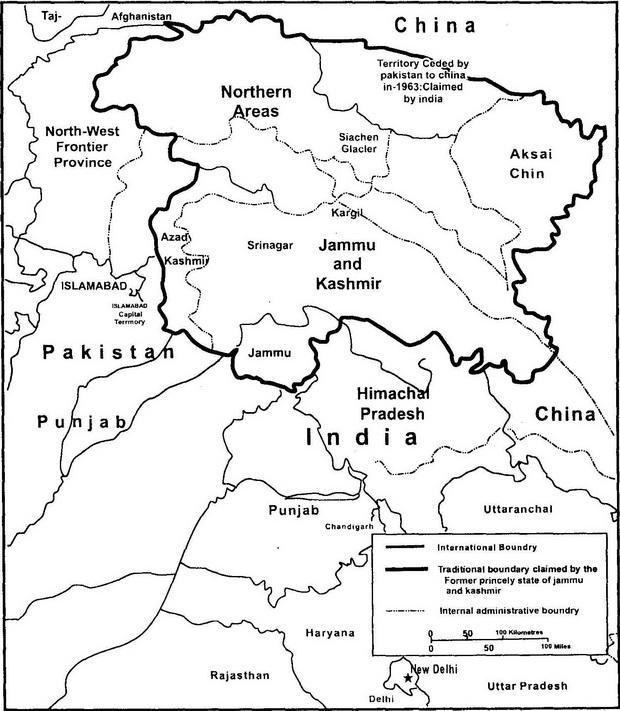Border Between Pakistan and India
Beyond the LoC, the entire border between India and Pakistan remains susceptible to problems that could easily spill out of control in the environment of suspicion. Many times India has amassed its troops on the Pakistan border, creating a tense environment between
the two countries. India accuses Pakistan of supporting infiltration via the LoC in order to stire’ the insurgency inside Indian Kashmir. Pakistan insists that the borders are porous and that the cause of the problems in Jammu and Kashmir is the harsh policies of New Delhi creating a real human rights problem.
Most of the 2900-km boundary between India and Pakistan is an internationally recognized border.
The border is formed between the Indian States of Punjab, Rajasthan, and Gujarat with the Pakistani provinces of Punjab and Sindh. The terrain varies from coastal salt marshes, through deserts, to the agricultural districts of the Punjab. While there is little official cross-border traffic, there is a great deal of smuggling and unofficial commerce. This area has also seen past conflict and near conflict accompanying large military deployments and military exercises.
Softening the Line of Control
The idea of softening, the line of control after October earthquake is a hot
controversial debate in India-Pakistan nowadays. A significant CBM, however, is that Pakistan and India have opened telephone communication, in addition to which both sides
have also agreed to open the LoC at five entry points, through which Kashmiris on both sides will be able meet and help each other in these difficult times.
Both sides can turn this natural calamity into an opportunity to wash away or at least dilute the bitter legacy of Partition when one million were killed and 20 million displaced. It will allow divided families to meet and share each other’s sorrows and assist each other in the tasks of reconstruction. There is also the expectation in some quarters that contact between Kashmiris from the two sides, thus made easier and more frequent, will somehow bring the governments of India and Pakistan closer to a final settlement of the Kashmir issue.

The opening the Srinagar-Muzafarra-bad road network is a giant step towards
solving the problems of millions on either side of the Line of Control (LoG). General Musharraf declared that his government is ready to open up the LoC and let any number of persons cross over, meet relatives, and assist them in their reconstruction efforts. The earthquake had offered an opportunity for India and Pakistan to move forward towards a
fina1 Kashmir settlement. He went on to call for demilitarization of the territory, presumably, on
both sides of the LoC. He thought political leaders on both sides should also have in creased interaction to help the process of reconstruction. Palistan has proposed demilitarization of the LoC and self-governance in Kashmir as interim measures to facilitate the final settlement of the Kashmir issue. But New Delhi has played down the Pakistani proposals, arguing that Jammu and Kashmir already enjoyed autonomy under the Indian constitution and had in placed a popular government elected through free and fair elections, the reason behind this conflict is again lack of trust.
However, the idea of softening’ the border between India and Pakistan along the state of Jammu and Kashmir is not a new one. It is an old idea that is being revived in a new context. The case for it is based mainly on humanitarian grounds, which are supposed to be above political considerations. The primary argument is that it will help families, currently divided, to reunite. These divided families are a permanent peculiarity of the illogical division of a society between two countries based on no particular principle other than the fact that the line of separation represented the respective militaries’ state of control as on a particular day. When the state of Jammu and Kashmir was divided into two halves between India and Pakistan on 1 January 1949 and the ceasefire line announced, families were divided, by a line, based on the territory held. In short, the separation was on a completely random basis. Since then, various proposals have surfaced from different quarters to open up the Jammu and Kashmir border.
The logic of softening LoC is totally irrelevant of the fact that t will help Pakistan in reconstruction and resettlement. The reason behind this is that government is thinking to built new town or new villages somewhat away from the destructed earth quake places like Muzzaffarabad will be reconstructed somewhat away from its origin and same is the case with Balakot and other destroyed areas. Hence there is no connection between softening of L0C and reconstruction work. Moreover, The Kashmiri people have never accepted the LoC
- or the earlier Ceasefire Line - and the Indians above also undermined the LoG by their frequent violations of it.